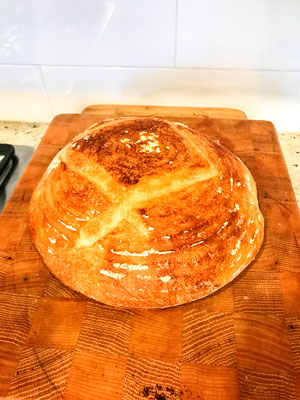Sourdough in Castle Valley
25 years in the making
By Celeste McNeil; photo courtesy of Bob Vick
With the slower pace of life the past several months, Bob Vick was looking for something to fill his time. He started gardening and built raised beds in the yard, and tried his hand at baking bread. With a shortage of commercial yeast, he turned to sourdough.
Vick and his Castle Valley neighbor Judy Manley both made sourdough starters or “leaven,” but neither batch really took off like it was supposed to. Manley reached out to a Facebook group dedicated to “the perfect sourdough” and asked if anyone was willing to share. A Denver woman gladly shared her leaven and the story of how she created it 25 years ago from a plum growing in her backyard.
The leaven Vick and Manley got was made from fruit and bacteria that grew here in Colorado; it’s acclimated to mile-high living. Vick, a former beekeeper said, “The beauty in a naturally developed starter is it takes on the character of the location it was created in. San Francisco sourdough has a specific flavor profile. This 25-year starter is really mellow in taste – kind of like Colorado.”
Baking sourdough is an art (see related story page 29), but an ancient one. Naturally fermenting bacteria found in flour is the traditional way to make bread, dating back thousands of years. The commercially produced yeast most of us use was developed about 150 years ago.
Sourdough is created using precise measurements of primarily flour and water. Some math is required to assure the ratios are correct. Ingredients are measured by mass not by volume.
Vick, a software engineer, said the technical aspects of sourdough baking appeal to his inner nerdiness, but he equally enjoys the art and craft of making artisan bread. “Baking good artisan bread is science. It’s hard work. It’s also art. I mix by hand. Why bother turning on a machine – you want to touch it, hear it, smell it. You need to be able to read the dough, to know when it’s happy. It’s more about feel and intuition.”
Baking artisan bread requires time and curiosity; it’s not about instant gratification. There are specific techniques for mixing the very wet dough, for shaping and scoring it before baking. To get the perfect blistery, thick crunchy crust with a soft large crumb interior, the water to flour ratio needs to be just so, and the baking needs to include steam, but only for the first third of the baking time.
Vick, who has been baking since he was a teenager in east Texas, has learned a lot from YouTube videos. He said, “If you like to learn, dive in and get into bread baking. You can find a recipe that you enjoy quickly. Professional bakers spend years, but the home baker can put as much or as little time into it. There’s nothing better than hot bread with butter.”
